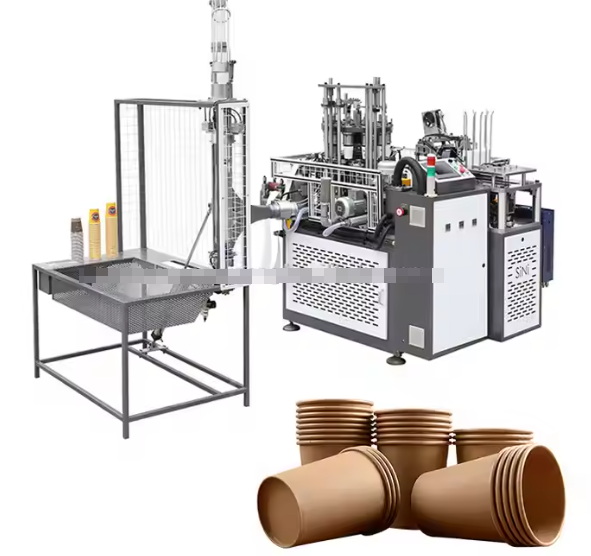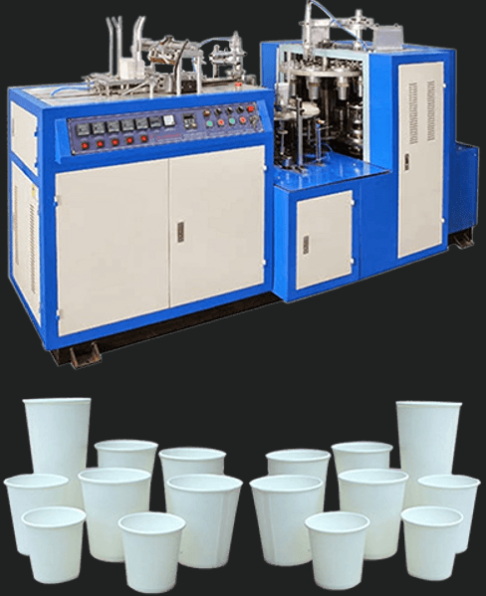
Content Menu
● Introduction to Disposable Cup Making Machines
>> Paper Cup Making Machines
>>> Operational Process of Paper Cup Machines
>> Plastic Cup Making Machines
>>> Operational Process of Plastic Cup Machines
● Trends in Disposable Cup Making Machines
>> Sustainability
>> Automation and Advanced Technologies
>> Customization
● Environmental Considerations
>> Sustainable Practices in Paper Cup Production
>> Sustainable Practices in Plastic Cup Production
● Future Developments
>> Technological Advancements
>> Market Expansion
● Conclusion
● Frequently Asked Questions
>> 1. What materials are used in disposable cup making machines?
>> 2. How do paper cup making machines work?
>> 3. What is the environmental impact of disposable cup making machines?
>> 4. Can disposable cup making machines produce different sizes and designs?
>> 5. What maintenance is required for disposable cup making machines?
● Citations:
Disposable cup making machines are integral to the production of both paper and plastic cups, which are ubiquitous in our daily lives. These machines automate the manufacturing process, ensuring efficiency and consistency in the production of cups for various beverages. In this article, we will delve into the workings of both paper and plastic disposable cup making machines, exploring their components, operational processes, and environmental considerations.

Introduction to Disposable Cup Making Machines
Disposable cups are made from materials such as paper, polypropylene (PP), polyethylene terephthalate (PET), and polystyrene (PS). The choice of material depends on the intended use of the cup, such as hot or cold beverages. The manufacturing process involves several stages, from raw material selection to the final packaging of the cups.
Paper Cup Making Machines
Paper cup making machines are designed to transform rolls of paper into functional cups. These machines are equipped with various components, including a paper feeding system, a forming area, and a sealing unit. The process involves cutting the paper into specific sizes, shaping it into a cylindrical form, and sealing the bottom and sides using heat or adhesive.
Operational Process of Paper Cup Machines
1. Paper Feeding: The machine unwinds the paper rolls and cuts them into the desired size.
2. Cup Forming: The cut paper is wrapped around a mandrel to form a cylindrical shape.
3. Sealing: The sides and bottom of the cup are sealed using heat or adhesive.
4. Rim Rolling: The top edge of the cup is rolled to create a smooth rim.
5. Stacking: The finished cups are stacked and prepared for packaging.
Plastic Cup Making Machines
Plastic cup making machines utilize thermoforming to shape plastic sheets into cups. The process involves heating the plastic to a high temperature and then molding it into the desired shape.
Operational Process of Plastic Cup Machines
1. Raw Material Selection: Choosing the appropriate plastic material based on the cup's intended use.
2. Thermoforming: Heating the plastic sheet and molding it into a cup shape.
3. Cutting: Removing excess plastic from the molded cup.
4. Stacking: Automatically stacking the cups for packaging.
Trends in Disposable Cup Making Machines
The market for disposable cup making machines is undergoing significant transformations, driven by trends such as sustainability, automation, and customization.
Sustainability
There is a growing demand for biodegradable and compostable cup materials, leading manufacturers to innovate in this area. Biodegradable paper cups, for instance, are made from renewable resources and are designed to break down naturally over time, minimizing environmental impact[2][5]. Similarly, plastic cup manufacturers are exploring biodegradable materials like PLA (polylactic acid) and PHA (polyhydroxyalkanoates), which are derived from renewable resources[7].
Automation and Advanced Technologies
Companies are increasingly integrating AI and IoT into cup making machines to enhance production accuracy, reduce waste, and optimize operational efficiency[1][3]. These technologies not only help manufacturers meet high demand but also enable them to produce cups at a lower cost, improving profit margins.
Customization
The trend towards customization is gaining momentum, with consumers and businesses seeking unique designs and branding on their cups. This has led to the development of machines that offer high levels of flexibility in production, allowing for the customization of cups in terms of size, shape, and design[1].
Environmental Considerations
Both paper and plastic cup making machines have environmental implications. Paper cups are generally more biodegradable, but they often contain a polyethylene (PE) lining to prevent leakage. Plastic cups, while convenient, contribute significantly to plastic waste and pollution. Manufacturers are exploring more sustainable materials and production methods to reduce environmental impact.
Sustainable Practices in Paper Cup Production
Biodegradable paper cup manufacturers prioritize environmentally friendly practices, such as using water-based inks and adhesives, and minimizing waste and energy consumption[2]. Some companies are adopting sustainable sourcing practices, using paper certified by organizations like the Forest Stewardship Council (FSC)[5]. Closed-loop recycling programs are also being implemented, where paper cups are collected, cleaned, and reused to create new paper products[5].
Sustainable Practices in Plastic Cup Production
The demand for biodegradable and recyclable plastic materials is driving innovations in plastic cup making machines. Many manufacturers are incorporating features that support the use of eco-friendly materials, such as PLA and PHA[3][7]. Energy-efficient machines are gaining popularity, as businesses aim to reduce operational costs and environmental impact[3].

Future Developments
The future of disposable cup making machines is likely to focus on enhancing environmental sustainability without compromising on functionality or cost-effectiveness. Innovations in material science, such as biodegradable coatings and plant-based plastics, will continue to play a crucial role in reducing the environmental footprint of disposable cups[6][8].
Technological Advancements
Technological advancements, including AI and IoT integration, will continue to improve production efficiency and reduce waste. Predictive maintenance and smart sensors will become more prevalent, allowing for real-time monitoring and optimization of production processes[4].
Market Expansion
The market for disposable cup making machines is expanding, particularly in emerging markets where demand for disposable cups is increasing rapidly[1]. This expansion includes the establishment of new manufacturing facilities and partnerships with sustainability initiatives to promote eco-friendly practices[1].
Conclusion
Disposable cup making machines play a crucial role in the production of paper and plastic cups. Understanding their operational processes and components can help optimize production efficiency and reduce environmental impact. As technology advances, we can expect more sustainable and eco-friendly solutions in the manufacturing of disposable cups.

Frequently Asked Questions
1. What materials are used in disposable cup making machines?
Disposable cup making machines use various materials, including paper, polypropylene (PP), polyethylene terephthalate (PET), and polystyrene (PS). The choice of material depends on the intended use of the cup.
2. How do paper cup making machines work?
Paper cup making machines work by unwinding paper rolls, cutting them into specific sizes, shaping them into cylindrical cups, sealing the sides and bottom, and rolling the rim for a smooth finish.
3. What is the environmental impact of disposable cup making machines?
Disposable cup making machines contribute to environmental issues, particularly with plastic waste. However, advancements in sustainable materials and production processes aim to mitigate these impacts.
4. Can disposable cup making machines produce different sizes and designs?
Yes, both paper and plastic cup making machines can produce cups of various sizes and designs by adjusting the machine settings or using different molds.
5. What maintenance is required for disposable cup making machines?
Regular maintenance is crucial for the longevity and efficiency of disposable cup making machines. This includes checking mechanical parts, lubricating moving components, and ensuring electrical systems are functioning correctly.
Citations:
[1] https://www.globalgrowthinsights.com/market-reports/cup-making-machines-market-101982
[2] https://www.sowinpak.com/news_details/The_Rise_of_Biodegradable_Paper_Cups_Sustainable_Solutions_for_a_Green_Future.html
[3] https://cn-thermoforming.com/plastic-cup-making-machine/
[4] https://insights.made-in-china.com/The-Future-of-Paper-Cup-Machines-Meeting-Evolving-User-Needs-and-Embracing-Technological-Advancements_xtRTrnUGNEIW.html
[5] https://www.heyipackaging.com/news_detail/20.html
[6] https://www.anirudhagroindustries.com/beyond-convenience-rethink-your-business-with-the-sustainable-impact-of-disposable-paper-cups/
[7] https://hotshotsleeves.com/plastic-cups/how-does-using-plastic-cups-or-disposable-cups-help-the-environment-stay-clean/
[8] https://www.yoonpak.com/manufacturing-of-paper-cups/
[9] https://www.mingyuanpapercupmachinery.com/disposable_paper_cup_machine_blog/1422.html
[10] https://www.mingyuanpapercupmachinery.com/disposable_paper_cup_machine_blog/1156.html
[11] https://www.mingyuanpapercupmachinery.com/disposable_paper_cup_machine_blog/1428.html
[12] https://www.linkedin.com/pulse/fully-automatic-paper-cup-making-machine-market-size-fjjsc
[13] https://www.linkedin.com/pulse/market-dynamics-future-trends-global-paper-cup-forming-9uyne
[14] https://insights.made-in-china.com/Types-Of-Machines-For-Making-Paper-Cups-How-To-Choose-The-Right-Equipment-For-Your-Business_JAuGSmzKTQHV.html
[15] https://www.globenewswire.com/news-release/2024/10/23/2967668/0/en/Global-Paper-Cups-Market-Forecast-Projected-Growth-to-USD-21-5-Billion-by-2034-Driven-by-Sustainable-Practices-Increasing-On-the-Go-Beverage-Consumption-and-the-Rise-of-Vending-Mac.html
[16] https://www.indiamart.com/proddetail/high-speed-open-cam-direct-bottom-new-technology-paper-cup-making-machine-2854004406288.html
[17] https://www.afandpa.org/news/2019/why-are-paper-cups-sustainable-choice
[18] https://www.futuremarketinsights.com/reports/paper-cup-machine-market
[19] https://www.justdial.com/jdmart/Coimbatore/Cup-Making-Machine/jdm-1295410-ent-2-13565276
[20] https://emeraldecovations.com/2024/08/exploring-the-environmental-impact-of-paper-cups/

















